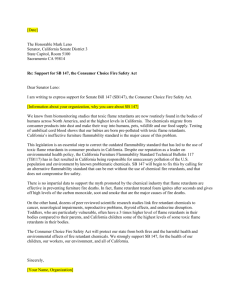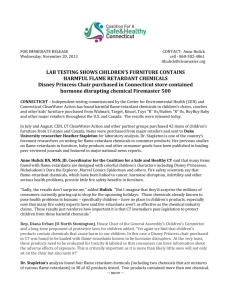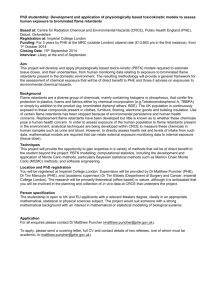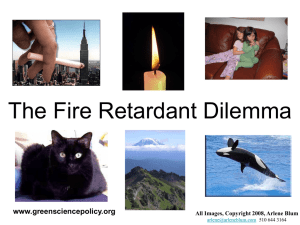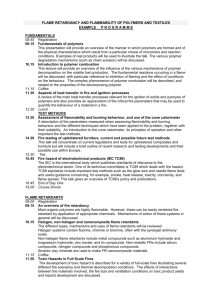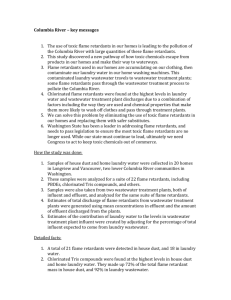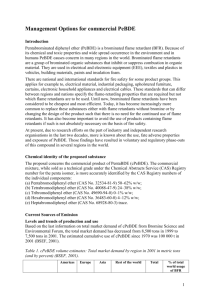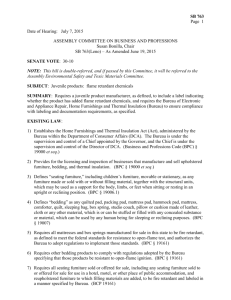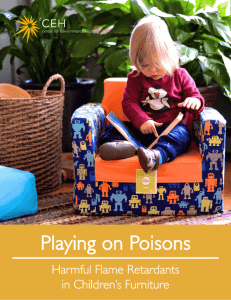Logline - Cloudfront.net
advertisement
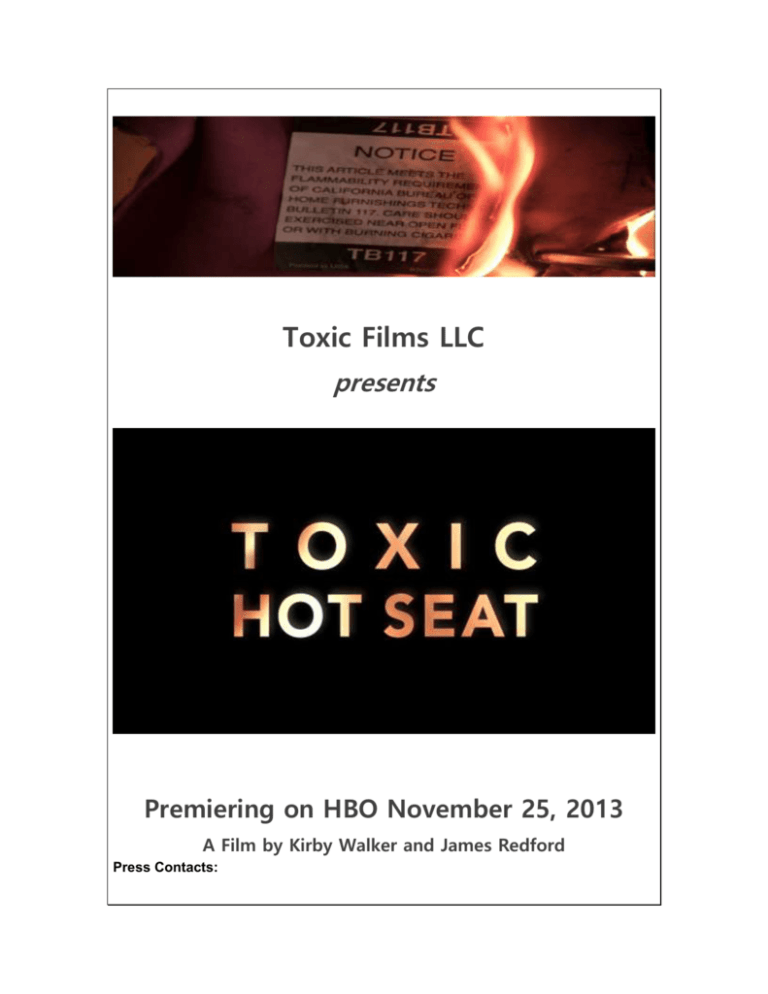
Toxic Films LLC presents Premiering on HBO November 25, 2013 A Film by Kirby Walker and James Redford Press Contacts: George Nicholis / Nicole Almira PMK*BNC Relations NY: 212-373-6113/LA: 310-854-4897 george.nicholis@pmkbnc.com nicole.almira@pmkbnc.com Lana Iny / Erik Batt HBO Media 212-512-1462/5879 lana.iny@hbo.com erik.batt@hbo.com Logline TOXIC HOT SEAT follows a courageous group of firefighters and mothers, journalists and scientists, politicians and activists as they fight to expose a deadly, multi-million dollar campaign of deception that’s left a toxic legacy in our homes and bodies - a campaign so cunning, it’s taken nearly 40 years to unravel. Synopsis – Short Chemical flame retardants are everywhere. Our furniture. Our homes. Our bodies. But do they work as promised? And are they making us sick? To answer these questions, TOXIC HOT SEAT dives into a deadly nexus of money, politics and power – and introduces us to a few brave citizens willing to stand their ground and demand an answer to an essential question: Why have we let 84,000 chemicals go largely unregulated in this country? Synopsis – Medium Chemical flame retardants are everywhere. Our furniture. Our homes. Our bodies. But do they work as promised? And are they making us sick? The three chemical companies producing flame retardants would prefer that we not ask these questions, and they’ve spent millions of dollars on lobbyists, publicists and influencers to ensure that we don’t. It might remind you of the Big Tobacco cover-up. Which makes sense, since Big Tobacco has had a hand in this, too. Set against the backdrop of the award-winning 2012 Chicago Tribune investigative series “Playing With Fire,” TOXIC HOT SEAT threads together an intricate story of manipulation that details how Big Tobacco skillfully convinced fire safety officials to back a standard that, in effect, requires all furniture to be filled with toxic flame retardants. The film continues to untangle how the chemical companies cover-up deadly risks to public health It exposes the chemical industries manipulation of chemical safety data by paying “experts” to alarm legislators and the public about the deadly risk of removing chemical flame retardants from our homes. Through the personal stories of a cancer-surviving firefighter, a renowned chemist whose work helped remove fire retardants from kid’s pajamas in the 1970s, and a brave and determined young Maine legislator and mom, TOXIC HOT SEAT reveals the courage of brave citizens willing to fight for the truth against a deadly nexus of money and politics. About the Issue California Technical Bulletin 117 is meant to do one thing: reduce the escalating death rates from house fires caused by cigarettes. TB117, penned in 1975, did this by demanding that the polyurethane foam inside most chairs and couches withstand a candle flame for 12 seconds. Although fires rarely start with the ignition of internal furniture foam but rather the fabric surrounding it, TB117 created a vast new market for chlorinated and brominated ethers. To streamline operations, furniture makers opted to use the fire retardant chemicals in all polyurethane foambased furniture, not just those items intended for sale in California. These chemicals – measured not in parts per billion but in pounds and ounces per couch – are dangerous. When UC Berkeley researchers identified one flame retardant used in children’s clothing with a high likelihood of causing cancer, Brominated Tris was banned from children’s pajamas in 1977. It wasn’t, however, banned from use in couches, strollers, car seats or nursing pillows. The Centers for Disease Control and Prevention (CDC) reports that fire retardant chemicals are found in more than 90% of American’s bodies, including in breast milk. This happens because Polybrominated Diphenyl Ethers (PBDEs) migrate into dust and then, not surprisingly, into humans (especially babies and toddlers who spend time close to the floor). Animals are not immune. The Canadian Department of Fisheries and Oceans and its National Water Research Institute have found fire retardants in tissue samples of killer whales and polar bears. Flame retardants, when ignited, also form cancer-causing dioxins. A November 2006 analysis of 32 studies in the Journal of Occupational and Environmental Medicine found that firefighters have significantly elevated rates of multiple myeloma, non-Hodgkin’s lymphoma, prostate, and testicular cancer. The impact that these chemicals have in the bodies of not just firefighters, but Americans everywhere, is staggering. Women exposed to flame retardants are less likely to achieve pregnancy, children are far more likely to have mental disorders, and people are getting cancers of the worst kind- liver, brain, kidney and testicular. But flame-retardants do their job, right? Dr. Vytenis Babrauskas, the lead author of a large government study done in 1987 on the effectiveness of fire retardants, says no. Although manufacturers of flame retardants have heralded this study as proof that flame retardants prevent fires, Dr. Babrauskas contends in a 2012 Chicago Tribune article that industry officials have “grossly distorted” his findings. He asserts that the real-world amounts of retardants used in today’s typical home furnishings, as opposed to the markedly larger studied amounts, provide “little to no fire protection.” Director’s Statement Storytelling - it’s how we make sense of the world. Our desire to create meaning in an often random and complex world resides deep within novelists, playwrights, journalists and screenwriters. To be human is to desire meaning, and storytellers are driven to provide that meaning - for themselves and for others. Documentary filmmakers are no different. We see an issue and say, “people ought to know about this.” We are compelled to share the stories and give a voice to those inspiring individuals working for justice who often go unheard. Documentary filmmaking is an arduous and lengthy process built upon the risky assumption that people need to hear the story. Ask any documentary filmmaker, however, and they will tell you that a good story always feels indisputably beyond question. That is certainly how we feel about story at the heart of our documentary, TOXIC HOT SEAT. Why do we use chemical flame-retardants in our furniture? Science shows that, although ineffective, they pose serious health concerns. Why do we allow America’s children to jump, crawl and nap on objects that might be harming their health? Most importantly, how do we stop this madness? The answers to these questions take us deep into the shadowy nexus of money, politics and power - and a few inspiring citizens who are leading the way towards positive change. In an era of depressing environmental stories that leave us feeling hopeless this is a story that we hope will outrage you and at the same time inspire you to join the movement. We hope you enjoy it! - Jamie and Kirby About the Filmmakers Kirby Walker Kirby is an award-winning independent film and video producer. She worked for CBS News in New York, and left to do graduate work in communications at Stanford University, where she received her MA in Communication in 1982. In 1982 she founded Omega Productions, an educational and corporate film and video and production firm where she produced and directed projects for numerous clients including: Apple, The Gap, Levi Strauss, Pacific Telesis. She is currently an Honorary Board member of the National Resources Defense Council in New York, and Summer Search San Francisco and has served on the boards of Marin Country Day School, and The Center for Investigative Reporting. She serves on the Advisory Committee for Golden Gate National Parks Conservancy. James Redford James writes, produces and directs for film and television. His latest directorial project, Aces, is a documentary film that explores the emerging link between childhood trauma and life-long health problems – and what can be done about it. He directed The Big Picture: Rethinking Dyslexia currently airing on HBO. He also produced the film Watershed about the Colorado River and the acclaimed HBO documentary Mann V. Ford. Additionally, James wrote and directed Quality Time, an award-winning short comedy starring Jason Patric. He recently combined his passion for music and directing in Andain’s new music video, Much Too Much. Other credits include producing The Kindness of Strangers which premiered at Sundance in 1999 and was picked up by HBO as well as adapting and directing Showtime’s Spin starring Stanley Tucci, Dana Delany, and Ruben Blades. Redford also wrote the original screenplays for Cowboy Up starring Kiefer Sutherland and Darryl Hannah as well as adapting Tony Hillerman’s Skinwalkers, a PBS/Mystery! series that was the highest-rated PBSscripted program of 2002. The Acting Thing, a comedic short written by James, was named best comedic short at the 1996 Houston Film Festival and aired on the Sundance Channel that same year. After surviving two liver transplants, James founded JRI, a non-profit dedicated to promoting a deeper understanding of the miraculous gift of organ donation. His live musical event, “Share the Beat“, has been performed across the country with the help of notable talents such as: Tim McGraw, Phil Vassar, Deana Carter, Ruben Blades, Dana Delaney, James Denton, Ryan Merriman, and Eric Stromer among others. James also plays guitar for Olive and the Dirty Martinis, a popular Bay Area rock and roll cover band. He is an avid surfer, cyclist, and skier and currently lives in Marin County, CA. To learn more, please visit www.jamesredford.com. Characters Arlene Blum Visiting Scholar, Chemistry University of California, Berkeley Tony Stefani Firefighter Andrew McGuire Lobbyist Sarah Janssen Chemist NRDC Avinash Kar Chemist NRDC Hannah Pingree Maine Legislator and Mom Anna Mascarenas Marcelo Hirshler, Ph.D. Patricia Callahan Investigative Reporter Chicago Tribune Sam Roe Chicago Tribune Michael Hawthorne Investigative Reporter Chicago Tribune Gordon Damant Author (TB117) Vytenis Babrauskas Fire Science and Technology, Inc. Karen Kerr Stone Don Lucas Chemist Lawrence Livermore Mark Leno Senator Tonya Blood Barbara Boxer Senator Gov. Jerry Brown Sharyle Patton Director, Health & Environmental Program Commonweal Ana Mascarenas Policy & Communications Coordinator PSR*LA Kathryn Alcano California Policy Director Center for Environmental Health Timeline 1920 A cigarette-ignited fire in Lowell, Massachusetts, caught the attention of U.S. Congresswoman Edith Nourse Rogers (D-MA); she called for the National Bureau of Standards (NBS) to develop technology for "self-snubbing" cigarettes. 1932 After three years of research, the NBS develops a “self-snubbing” cigarette. No cigarette manufacturers incorporate the idea. 1975 Frustrated by the number of residents dying in fires caused by cigarettes, California introduces Technical Bulletin 117, a consumer fire safety code that requires polyurethane (found in most upholstered furniture) withstand a candle flame for 12 seconds. To comply, manufacturers start using up to two pounds of fire retardant chemicals on the typical medium-sized sofa. *(Don Lucas, flammability expert at Lawrence Berkeley National Laboratory) 1976 Toxic Substances Control Act (TSCA) becomes the nation’s primary chemical safety law. By grandfathering the 62,000 chemicals on the market, the EPA does not have to review their safety. 200 actually tested. 5 restricted. 1977 Research by UC Berkeley researchers Arlene Blum and Bruce Ames on brominated Tris used as a flame retardant identifies that it acts as a mutagen – it damages DNA – with a high likelihood of causing cancer. Consumer Product Safety Commission, an independent agency of the U.S. government that reports to Congress and the President, bans brominated Tris from children’s pajamas. 1983 Demand for flame-retardants is 526 million pounds. (The Freedonia Group) 1987 The chemical industry commissions the National Bureau of Standards to conduct the first large-scale study of the effectiveness of fire retardants. Specially designed chairs, TVs and electrical cables are covered with large amounts of the most potent and expensive chemicals. Retarded samples provide 15 times more escape time than non-treated items. Manufacturers of flame-retardants hail the study as proof that the chemicals prevent residential fires and save lives. Author of the study, Dr. Vytenis Babrauskas, maintains in a 2013 Chicago Tribune article that “the companies grossly distorted” the findings of his research, which was not based on realworld conditions. The small amounts of flame retardants in typical home furnishings, he said, offer little to no fire protection.” A report funded by the Cigarette Safety Act to Congress states that it is technically feasible and maybe commercially feasible to make a cigarette that is less likely to start fires. 1989 National Association of State Fire Marshals is founded with help from Peter Sparber, a former Tobacco Institute VP. 2006 Arlene Blum discovers manufacturers are using chlorinated Tris on polyurethane foam in furniture cushions, nursing pillows, car seats and other consumer products to meet California’s Technical Bulletin 117. 2007 California State Rep. Sally Lieber (D-Mountain View) introduces AB513 to outlaw a brominated flame retardant called deca (short for decabrominated diphenyl ether or deca-BDE). The bill fails on the Assembly floor. Chemical industry’s lobbying campaign is successful. 2008 Dr. Ami Zota at the University of California, San Francisco finds levels of fire retardant penta-BDE in California house dust that is 4 to 10 times higher than other areas in the US and 200 times higher than in Europe. She also find penta-BDE in the blood of California residents at levels twice as high as the national average. State Rep. Mark Leno (D-CA) introduces AB706 to prohibit all forms of brominated and chlorinated flame-retardants in upholstered furniture and bedding products such as pillows, comforters, and mattresses. Bill fails on the Senate floor in 2008. Global flame retardant market worth $4.1 billion. (BCC Research, a market forecasting group) 2009 State Rep. Mark Leno introduces SB772 to exempt strollers, infant carriers, bassinets and nursing pillows from flame retardant treatments because they have proven to pose no fire risk. The bill passes a Senate floor vote but fails to win the majority needed to pass the 17-member Assembly Appropriations Committee. Again, the chemical industry’s campaign to keep regulations from becoming law, is successful. 2010 State Rep. Mark Leno introduces SB1291 to place flame-retardants under the regulatory control of the state’s Green Chemistry Initiative. Mandates review of new flame-retardants before they can be added to consumer products. Bill fails on the Senate floor by one vote. 2011 Undaunted, State Rep. Mark Leno introduces SB147 to reduce flame retardant exposure. Bill calls for a smolder flammability test instead of the current open flame test so that manufacturers would not have to use flame-retardants. Bill killed in committee by a vote of seven to one. Senator Frank Lautenberg (D-NJ) introduces the Safe Chemicals Act California Office of Environmental Health Hazard Assessment lists chlorinated Tris as a cancer-causing chemical under Proposition 65. 2012 28 states considering toxic chemical legislation. 2008 - 2012 Chemical industry spends at least $23.2 million lobbying California officials and donating to campaigns to defeat flame retardant legislation. 2013 A UC Davis study of mice showed brain damage from a leading flameretardant, The study offers a possible pathway by which flame retardants lead to autism in humans. Department of Health in the state of Washington states that mattresses, mattress pads, couches, easy chairs, foam pillows, carpet padding, and other foam products purchased before 2005 contain chemicals dangerous to breathe in. 2014 Demand for flame-retardants projected by The Fredonia Group to be 4.4 billion pounds. Credits Produced and Directed by James Redford and Kirby Walker Edited by Jen Bradwell Cinematography by John Kiffmeyer Tylor Norwood Music by Daniel Lanois Additional Camera Gregg Betonte Peter Kent Erik Van Lenten Alan Hereford Joseph Hudson Blue Hour Films Sound Recording Dylan Hurley Additional Sound Marshal Stacks Javier Roberto Carlos Tom Holman Seattle Sound Line Producer Brook Holston Production Coordinator Shannon Stirone Associate Producer Cassandra Jabola Additional Editing Jeffrey Boyette Assistant Editors Joel White Luke Shock Remedy Editorial Sound Design and Re-recording Mixer Bob Edwards
